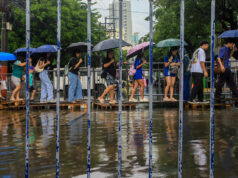Cavite, Laguna, Batangas seen to grow further
By Denise A. Valdez, Reporter
INDUSTRIAL activities in the areas of Cavite, Laguna and Batangas are seen to rise in the next two years, driven by improved connectivity and the growing commercial landscape in the south, real estate services firm Colliers Philippines said.
In the report “Property Upside Down South: Industrial and infrastructure investments to boost Southern Luzon residential property” by the local office of Colliers International, it said the “CALABA” (Cavite-Laguna-Batangas) corridor is likely to strengthen its position as the primary industrial hub with support from the government’s infrastructure plan.
“Colliers believes that robust industrial activities in the corridor are likely to continue over the next 12 to 24 months. With improving infrastructure connectivity and growth of commercial activities, we see the region also becoming a hotbed for township developments that feature residential projects,” it said.
“The region’s competitiveness as an industrial hub should further be enhanced by the infrastructure projects lined up by the government. These factors have also been enticing developers to build integrated communities and standalone residential projects to cater to rising demand in the region,” it added.
While the report was prepared before the Taal volcano erupted on Sunday, eventually leading to thousands evacuated from nearby areas, Colliers Research Manager Joey Roi H. Bondoc said he believes it is business as usual for many of the industrial facilities in the region.
“Of course in the nearby (areas), (those) closest to Taal, there’ll be concerns. But outside of that area, especially where the industrial operations are located, it will still be business as usual and there will still be a complementing demand for industrial parks, warehouses and houses,” Mr. Bondoc said in a phone call on Thursday.
He added while it is expected that prices will go down in the near term due to “knee-jerk reactions” of unit owners, he believes it is a “cyclical business where we will see a decline but we will also see a recovery.”
“While some unit owners are selling, there are opportunistic buyers waiting,” Mr. Bondoc said. “We cannot comment how long will the jitters in the market be, and the decline in prices and by how much, and how long recovery (will take) in terms of prices. But I think in the near term, ‘Will there be a decline?’ Yes.”
In its report, Colliers encouraged developers at the CALABA corridor to make way for industrial parks, align their expansion plans with the government’s infrastructure program, invest in modernizing warehouses, come up with strategic landbanking plans, expand township projects further, find ways to differentiate integrated communities and complement industrial parks with residential projects.
While the report was optimistic about the potential growth of the region, Mr. Bondoc said he expects delays in the completion of some new projects, thus impacting supply and posing as the biggest threat for CALABA’s prospects.
Meanwhile, the Philippine Economic Zone Authority (PEZA) issued a statement yesterday guaranteeing ecozone locators are locating away from “disaster-prone areas.”
“PEZA management and concerned zone managers in Luzon are coordinating accordingly with locator companies about the condition of affected workers who reside in affected areas of the Taal volcanic activities,” Director General Charito B. Plaza said in the statement.
She specifically mentioned the Lima Technology Center and the First Philippine Industrial Park in Batangas, which were not damaged by the Taal volcano eruption but were told to “craft their business continuity plans that should outline how they plan to do business in the face of the volcano’s ongoing activity.”
Colliers’ Mr. Bondoc said it is only apt for businesses to take precautionary measures if they are immediately affected by the natural calamity, but he noted there are plenty of industrial parks that are operating normally which will drive growth for the CALABA corridor.
“For those industrial parks where it’s business as usual, we still see a robust demand or robust industrial activities,” he said.




